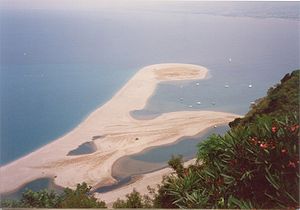Battle of Tyndaris
| Battle of Tyndaris | |||||||
|---|---|---|---|---|---|---|---|
| Part of the First Punic War | |||||||
 Lagoon and coast of Tindari. | |||||||
| |||||||
| Belligerents | |||||||
| Rome | Carthage | ||||||
| Commanders and leaders | |||||||
| Gaius Atilius Regulus | Hamilcar | ||||||
| Strength | |||||||
| Unknown | Unknown | ||||||
| Casualties and losses | |||||||
| 9 ships sunk |
18 ships 8 ships sunk 10 ships captured | ||||||
The Battle of Tyndaris was a naval battle of the First Punic War that took place off Tyndaris (modern Tindari) in 257 BC. Tyndaris was a Sicilian town founded as a Greek colony in 396 BC located on the high ground overlooking the Tyrrhenian Sea in the Gulf of Patti. Hiero II, the tyrant of Syracuse, allowed Tyndaris to become a base for the Carthaginians. The battle took place in the waters between Tyndaris and the Aeolian Islands, with Gaius Atilius Regulus in command of the Roman fleet.[1] Subsequently, the town fell to Rome.
The battle
Gaius Atilius Regulus' fleet was anchored off Tyndaris when he observed the Carthaginian fleet sailing past, without it being arranged in a tactical formation. He gave orders for the main body of his ships to follow the leading ships. He then took an advance guard of ten ships and sailed towards the Carthaginians. The Carthaginians noticed that the advance guard had managed to outdistance the main body of the Roman fleet and that other Romans were still boarding their ships. Taking the initiative, the Carthaginians turned and engaged the Roman squadron and sank nine Roman ships.[2] Meanwhile, the rest of the Roman fleet arrived and formed a line. The Romans then engaged the Carthaginians, sinking eight and capturing ten of their ships. The remainder of the Carthaginian ships retreated to the Aeolian Islands.[3]
This naval engagement was followed by the battle of Cape Ecnomus.

